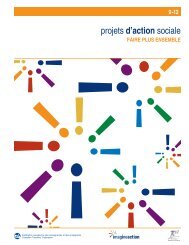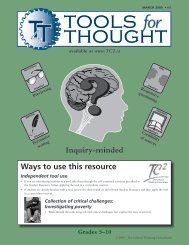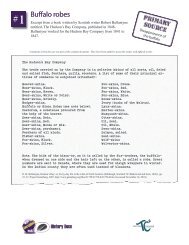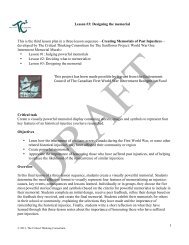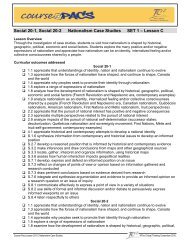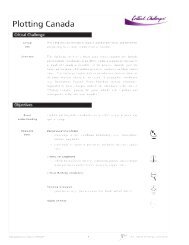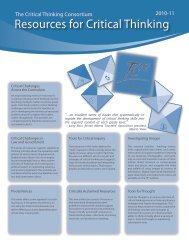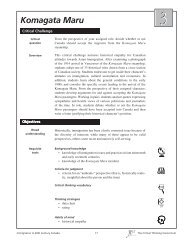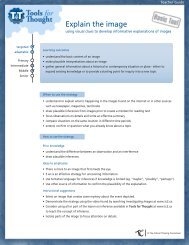Lesson A Introduction to Ultranationalism - The Critical Thinking ...
Lesson A Introduction to Ultranationalism - The Critical Thinking ...
Lesson A Introduction to Ultranationalism - The Critical Thinking ...
Create successful ePaper yourself
Turn your PDF publications into a flip-book with our unique Google optimized e-Paper software.
JUDGING THE TURNING POINT<br />
Practise identifying turning points<br />
Help students determine the point at which one thing evolves in<strong>to</strong> another<br />
by using two examples: the life cycle of a frog and Joe’s ―I am Canadian‖<br />
rant. Invite students <strong>to</strong> explain their opinions of the point at which a tadpole<br />
becomes a frog, and the point at which Joe becomes ultrapassionate about<br />
being Canadian.<br />
Identify criteria for a turning point<br />
Take students through the criteria of a turning point, as it pertains <strong>to</strong><br />
nationalism becoming ultranationalism.<br />
Challenge students <strong>to</strong> evaluate the criteria. Invite them <strong>to</strong> add or change<br />
parts that, upon reflection, could make the criteria better. To ensure they<br />
are clear about the key elements of the criteria (since they will be using<br />
these throughout this set), invite students <strong>to</strong> highlight key words in each<br />
criterion.<br />
Prepare a collage <strong>to</strong> reflect understanding<br />
This culminating activity involves the creation of a collage <strong>to</strong> represent<br />
events that range from clearly nationalistic <strong>to</strong> clearly ultranationalistic. One<br />
of the key components of this assignment is the appropriate identification of<br />
the turning point at which nationalism becomes ultranationalism. Facilitate<br />
students’ research of his<strong>to</strong>rical and contemporary examples. Help students<br />
learn how <strong>to</strong> annotate their pictures <strong>to</strong> show they understand the events<br />
they choose.<br />
If you find that students experience difficulty getting started, you can<br />
take them through a practice activity involving the placement of some<br />
suggested ideas along a continuum from nationalism <strong>to</strong> ultranationalism.<br />
<strong>The</strong>y can use these general ideas <strong>to</strong> find real-world examples that<br />
illustrate them.<br />
Use the rubric provided <strong>to</strong> assess the collage. Look for visuals that<br />
represent increasing intensity, a clear turning point, an effective<br />
explana<strong>to</strong>ry paragraph or presentation and visual appeal.<br />
- p. 138 discusses<br />
the concept of<br />
ultranationalism<br />
and begins <strong>to</strong><br />
explore the line<br />
where nationalism<br />
turns <strong>to</strong> ultranationalism<br />
COMPLEMENTARY INFORMATION<br />
- p. 132 discusses<br />
the concept of<br />
ultranationalism<br />
and begins <strong>to</strong><br />
explore the line<br />
where nationalism<br />
turns <strong>to</strong> ultranationalism<br />
SB Page 3 Students check<br />
one of the number bubbles<br />
that represent life-cycle<br />
stages and write a rationale.<br />
SB Page 4 Students draw a<br />
fulcrum along the<br />
continuum of <strong>to</strong>pics in Joe’s<br />
rant.<br />
SB Page 4 Students copy<br />
the criteria of a turning point<br />
in the box provided.<br />
SB Page 4-5 Students read<br />
the collage instructions.<br />
SB Page 5 Students<br />
complete the collage on a<br />
separate page of poster<br />
paper.<br />
Students write ideas from<br />
the box on the appropriate<br />
spot on a spectrum of<br />
nationalism <strong>to</strong><br />
ultranationalism.<br />
SB Page 6 Students use<br />
the rubric <strong>to</strong> guide them in<br />
completing their project.<br />
- chapter 8 explores<br />
examples of<br />
nationalism and<br />
ultranationalism in<br />
times of conflict<br />
- p. 166 helps <strong>to</strong><br />
define the concept of<br />
ultranationalism<br />
3<br />
Course-Pacs <strong>Lesson</strong> 20-3A <strong>Introduction</strong> <strong>to</strong> <strong>Ultranationalism</strong> ©<strong>The</strong> <strong>Critical</strong> <strong>Thinking</strong> Consortium 2010



